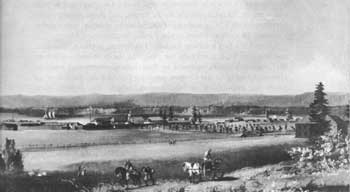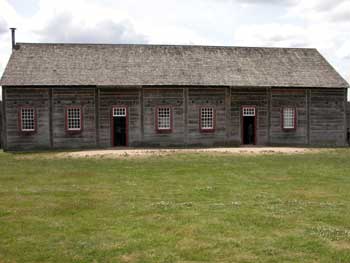






Survey of Historic Sites and Buildings
 |
FORT VANCOUVER NATIONAL HISTORIC SITE Washington |
 |
| ||
This fort served for two decades as the headquarters and depot for all activities of the Hudson's Bay Company west of the Rocky Mountains. As such, it was the economic, political social, and cultural hub of an area now comprising British Columbia, Washington, Oregon, Idaho, and western Montana.
 |
| Fort Vancouver, founded in the 1820's by the Hudson's Bay Company, served as headquarters and depot for all activities of the company west of the Rocky Mountains. For two decades it was one of the most important settlements in the Pacific Northwest and pioneered in wide-scale agriculture. (This photograph is from a watercolor made about 1845 by an unknown artist and now part of the Coe Collection of Western Americana, Yale University.) |
The fur resources of the Pacific Northwest were discovered by British seamen who visited the coast about the time of the American War for Independence, traded with the Indians, and discovered that the furs brought fantastic prices in China. Soon traders from several European countries, Canada, and the newly formed United States were vigorously competing in the trade. After years of bitter contest, the Hudson's Bay Company, a British firm chartered in 1670, won a dominant position.
In 1824 the company decided to move its western headquarters from Fort George, at the mouth of the Columbia River, to a site about 100 miles upstream. The shift was made to strengthen British claims to the territory north of the Columbia and to obtain better farming lands. Built in 1824-25, the fort was named for Capt. George Vancouver, the famous English explorer. In 1829 the company built a new fort a mile to the west, closer to the Columbia River.
For the next 20 years the fort was the most important settlement in the Pacific Northwest. Under the leadership of Chief Factor John McLoughlin, it monopolized the fur trade in the Oregon country and became the nerve center of a vast commercial empire that ranged from the Rockies to the Pacific and from Russian Alaska to Mexican California.
 |
In addition to trading activities, the Hudson's Bay Company fostered farming and manufacturing. In 1825, using seeds and grain imported from England, personnel at the fort made the first plantings on 300 acres in the vicinity and later cultivated thousands of acres of land along the north bank of the Columbia River. They also established orchards. The fort milled enough flour to supply the company's needs in the entire region and also processed salmon and lumber. As mills, drying sheds, forges, and shops sprang up, it developed into a large-scale agricultural and industrial community, a pioneer in such activities in the Pacific Northwest.
Around the fort a village formed. Tradesmen, artisans, boatmen, and laborers built homes on the plains to the west and southwest. McLoughlin's encouragement to American pioneers and missionaries emigrating to the Oregon territory fostered the growth of an American population in the region, which the British then controlled.
According to the treaty of 1846 between the United States and Great Britain, which established the 49th parallel as the southern boundary of Canada, Fort Vancouver was in U.S. territory. Thereafter the influence of the fort and the Hudson's Bay Company declined rapidly. U.S. settlers began to take over the land near the fort, and the village surrounding it expanded. In 1849 the U.S. Army organized a post at the fort. Within a couple of decades a fire destroyed all traces of the old stockade.
Fort Vancouver National Historic Site, established in 1954, contains 89 acres. Archeologists have uncovered a large quantity of artifacts, as well as remains of the stockade and building foundations.
 |
 |
http://www.cr.nps.gov/history/online_books/prospector-cowhand-sodbuster/sitea6.htm
Last Updated: 22-May-2005